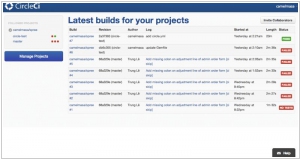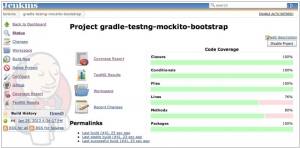CircleCI vs Jenkins
May 29, 2023 | Author: Michael Stromann
8

Languages, databases, queues, browsers, deployment, we support all of your tools. If it runs on Linux, then it will work on CircleCI. We'll even be around to help you install your own tools. The best development teams in the world trust us as their continuous integration and delivery solution because of our unmatched support and our ability to scale with them. We're built for teams.
CircleCI and Jenkins are both popular continuous integration and continuous deployment (CI/CD) platforms, but they differ in several key aspects.
CircleCI is a cloud-based CI/CD platform that emphasizes simplicity and ease of use. It offers a straightforward setup process and integrates well with popular version control systems like GitHub and Bitbucket. CircleCI provides a user-friendly interface, allowing developers to easily configure and manage their builds and workflows. It supports parallel and distributed builds, provides customizable build pipelines, and offers a wide range of pre-configured environment options for different programming languages and frameworks. CircleCI also provides advanced features like caching and test parallelization. As a cloud-based solution, CircleCI handles infrastructure management, scaling, and maintenance, reducing the administrative burden on development teams.
Jenkins, on the other hand, is a widely adopted open-source CI/CD tool with extensive flexibility and customization options. It can be hosted on-premises or in the cloud and offers a high degree of configurability. Jenkins supports a vast ecosystem of plugins, enabling developers to customize and extend its functionality. It provides a wide range of build and deployment options, allowing users to define complex workflows and integrations. Jenkins is known for its robustness, extensibility, and support for large-scale enterprise projects. However, it requires more initial configuration and management effort compared to a cloud-based solution like CircleCI
See also: Top 10 Continuous Integration tools
CircleCI is a cloud-based CI/CD platform that emphasizes simplicity and ease of use. It offers a straightforward setup process and integrates well with popular version control systems like GitHub and Bitbucket. CircleCI provides a user-friendly interface, allowing developers to easily configure and manage their builds and workflows. It supports parallel and distributed builds, provides customizable build pipelines, and offers a wide range of pre-configured environment options for different programming languages and frameworks. CircleCI also provides advanced features like caching and test parallelization. As a cloud-based solution, CircleCI handles infrastructure management, scaling, and maintenance, reducing the administrative burden on development teams.
Jenkins, on the other hand, is a widely adopted open-source CI/CD tool with extensive flexibility and customization options. It can be hosted on-premises or in the cloud and offers a high degree of configurability. Jenkins supports a vast ecosystem of plugins, enabling developers to customize and extend its functionality. It provides a wide range of build and deployment options, allowing users to define complex workflows and integrations. Jenkins is known for its robustness, extensibility, and support for large-scale enterprise projects. However, it requires more initial configuration and management effort compared to a cloud-based solution like CircleCI
See also: Top 10 Continuous Integration tools



